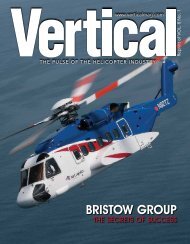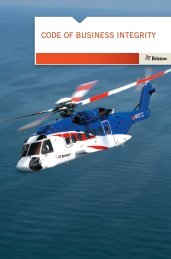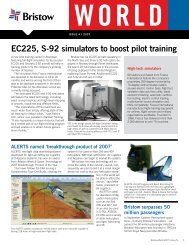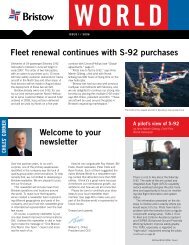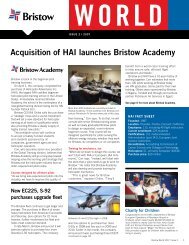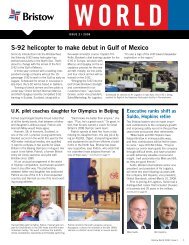Bristow Responds to Challenge of EC225 Fleet Suspension
Bristow Responds to Challenge of EC225 Fleet Suspension
Bristow Responds to Challenge of EC225 Fleet Suspension
Create successful ePaper yourself
Turn your PDF publications into a flip-book with our unique Google optimized e-Paper software.
BRISTOW RESPONDS TO CHALLENGE OF<br />
<strong>EC225</strong> FLEET <strong>Suspension</strong><br />
<strong>Bris<strong>to</strong>w</strong>’s action following the <strong>EC225</strong> fleet suspension was remarkable for<br />
what it says about the company’s financial strength and resilience.<br />
News <strong>of</strong> the controlled landing <strong>of</strong> another opera<strong>to</strong>r’s <strong>EC225</strong> in<strong>to</strong><br />
the North Sea on Oc<strong>to</strong>ber 22, 2012, flashed across the oil and gas<br />
and production plans have had <strong>to</strong> be modified. In some cases,<br />
production platform and drilling rig shutdowns have been threatened.<br />
industry, the second such incident in six months. It didn’t take long for<br />
<strong>Bris<strong>to</strong>w</strong> <strong>to</strong> react and ground its global fleet <strong>of</strong> <strong>EC225</strong>s, pending further<br />
investigation by authorities including the UK. Air Accidents Investigation<br />
Branch (AIB) and Eurocopter in<strong>to</strong> the root cause, attributed currently <strong>to</strong><br />
cracks in the vertical shafts <strong>of</strong> a gearbox. Eurocopter supports the UK<br />
Senior Vice President <strong>of</strong> Commercial Mark Duncan says <strong>Bris<strong>to</strong>w</strong><br />
contacted its clients within hours <strong>of</strong> the suspension. “We began <strong>to</strong> work<br />
immediately on how <strong>to</strong> utilize our global resources and think ‘out <strong>of</strong> the<br />
box’ <strong>to</strong> help clients replace their lost coverage.”<br />
AIB in determining the root cause.<br />
The challenge facing <strong>Bris<strong>to</strong>w</strong> was significant. “We were already facing<br />
Not only <strong>Bris<strong>to</strong>w</strong> suspended <strong>EC225</strong> flights; most <strong>of</strong> the <strong>of</strong>fshore<br />
helicopter industry did so, grounding some 80 aircraft globally. Since<br />
then, clients and helicopter companies have been scrambling <strong>to</strong> replace<br />
a very tight supply situation, and taking the <strong>EC225</strong> out <strong>of</strong> the picture<br />
has only made it worse,” says Duncan. “So we made a decisive move <strong>to</strong><br />
aggressively pursue expansion <strong>of</strong> our fleet <strong>of</strong> heavy aircraft.”<br />
coverage with their inven<strong>to</strong>ry <strong>of</strong> other aircraft. The situation has grown<br />
increasingly difficult; with reduced helicopter transport, some oil<br />
company personnel have remained longer than planned on platforms,<br />
Because <strong>of</strong> its disciplined and prudent balance sheet management<br />
strategy, <strong>Bris<strong>to</strong>w</strong> had the financial capability <strong>to</strong> respond quickly. Within<br />
6 <strong>Bris<strong>to</strong>w</strong> World 2013 Issue 1
days <strong>of</strong> the landing incident, <strong>Bris<strong>to</strong>w</strong> had ordered an additional 10<br />
Sikorsky S-92s <strong>to</strong> be delivered between July 2013 and December 2014,<br />
in the process. This is an incredible effort and really demonstrates the<br />
commitment <strong>of</strong> the engineers and support staff in Aberdeen.”<br />
and secured options for another 16 for 2015 and beyond.<br />
“It has been a big job bringing back the AS332s, and both EBU and<br />
<strong>Bris<strong>to</strong>w</strong> quickly diverts all available aircraft<br />
COBU did a fantastic job with the overhauls and rebuilds,” Duncan says.<br />
The suspension <strong>of</strong> <strong>EC225</strong> flights hit <strong>Bris<strong>to</strong>w</strong>’s base in Aberdeen, Scotland,<br />
the hardest, grounding 12 aircraft out <strong>of</strong> a fleet <strong>of</strong> 14. Bases in Norway,<br />
Australia and Malaysia each removed two or three <strong>EC225</strong>s from service.<br />
<strong>Bris<strong>to</strong>w</strong>’s recent acquisition <strong>of</strong> Cougar in Nova Scotia also proved timely.<br />
“We were able <strong>to</strong> transfer aircraft from Cougar in Canada <strong>to</strong> Aberdeen<br />
on a short-term basis, which gave us additional capacity,” Duncan says.<br />
The first priority was <strong>to</strong> replace the suspended <strong>EC225</strong>s in Aberdeen.<br />
<strong>Bris<strong>to</strong>w</strong> was able <strong>to</strong> divert new heavy and medium aircraft from its<br />
“In the Canadian Atlantic, they operate in similar conditions <strong>to</strong> the North<br />
Sea, so the aircraft were easily adaptable.”<br />
operations in the Gulf <strong>of</strong> Mexico and Nigeria, bringing the Aberdeen fleet<br />
<strong>to</strong> its current level <strong>of</strong> active aircraft. As part <strong>of</strong> this effort, <strong>Bris<strong>to</strong>w</strong> also<br />
brought back in<strong>to</strong> service six AS332 Super Pumas that were slated for<br />
sale. One <strong>of</strong> the biggest challenges was getting the AS332s refurbished<br />
and recertified.<br />
<strong>Bris<strong>to</strong>w</strong> pilots retrain<br />
Since pilots are trained for a specific aircraft type, each pilot moving <strong>to</strong> a<br />
new type <strong>of</strong> aircraft is required <strong>to</strong> undergo training that could take from<br />
weeks <strong>to</strong> months. Because <strong>of</strong> demand, a unique challenge then arose<br />
in finding training aircraft and simula<strong>to</strong>rs.<br />
“Working with our colleagues in EBU and AUSBU, our COBU team in<br />
Aberdeen is bringing these six aircraft back in<strong>to</strong> service in about six<br />
months,” says John Cloggie, Direc<strong>to</strong>r <strong>of</strong> <strong>Bris<strong>to</strong>w</strong>’s Centralized Operations<br />
Business Unit (COBU). “Thousands <strong>of</strong> man hours are being expended<br />
“Every available aircraft is doing crew change operations, so is not<br />
available for training,” Duncan says. Again, <strong>Bris<strong>to</strong>w</strong>’s investment in<br />
training and resources has paid <strong>of</strong>f. “Fortunately, we have our own<br />
<strong>Bris<strong>to</strong>w</strong> World 2013 Issue 1 7
simula<strong>to</strong>rs for some aircraft types. We also have strong relationships<br />
with external training consultants. For the Sikorsky S-92, for example,<br />
we’ve booked every simula<strong>to</strong>r slot we can get in the world.”<br />
and everyone is looking <strong>to</strong> ramp up their activity. All markets are in a<br />
growth cycle for the first time in a number <strong>of</strong> years, putting extra strain on<br />
resources and significantly changing the supply demand balance.<br />
Duncan notes that all <strong>of</strong> <strong>Bris<strong>to</strong>w</strong>’s business units have been working<br />
<strong>to</strong>gether <strong>to</strong> find pilots for certain aircraft types in addition <strong>to</strong> getting<br />
aircraft where they are needed. Pilots are also providing support <strong>to</strong><br />
clients by visiting bases and talking with passengers.<br />
All <strong>of</strong> which raises the question: When will the <strong>EC225</strong>s return <strong>to</strong> <strong>of</strong>fshore<br />
transport? As <strong>of</strong> <strong>Bris<strong>to</strong>w</strong> World’s publication date, word from the UK Civil<br />
Aviation Authority is that it will not lift <strong>EC225</strong> operating restrictions until<br />
Eurocopter is able <strong>to</strong> show it has a fix.<br />
Duncan commends the quick response by <strong>Bris<strong>to</strong>w</strong> global operations.<br />
“The fact that we’ve been able <strong>to</strong> respond at the level we have is a<br />
testament <strong>to</strong> our people on the front lines and the careful planning<br />
In the meantime, <strong>Bris<strong>to</strong>w</strong> is not waiting for resolution <strong>of</strong> the issue; it’s<br />
already adapting its business strategy <strong>to</strong> cover the <strong>EC225</strong> gap and<br />
accommodate its clients as they move farther <strong>of</strong>fshore.<br />
and investment in resources that will continue <strong>to</strong> be part <strong>of</strong> our<br />
commitment <strong>to</strong> operational excellence. We really are saving our clients<br />
from production platform and drilling rig shutdowns.” And despite the<br />
challenges, <strong>Bris<strong>to</strong>w</strong> continues <strong>to</strong> strive <strong>to</strong> achieve Target Zero on safety.<br />
Jon Stripling, Direc<strong>to</strong>r, Global Standards, Quality, Safety & Training,<br />
says the situation “is being managed carefully and properly by the<br />
<strong>Bris<strong>to</strong>w</strong> has commitments for six AW189s <strong>to</strong> be delivered starting in<br />
2014 and five EC175s <strong>to</strong> be delivered starting in 2015. Over the next<br />
two years, a significant number <strong>of</strong> brand-new aircraft – S-92s, AW139s<br />
and 189s, EC175s and S-76Ds – will be added <strong>to</strong> its global fleet <strong>to</strong> meet<br />
market demand and address clients’ <strong>of</strong>fshore requirements.<br />
organization, but we have <strong>to</strong> remain vigilant <strong>to</strong> the extra pressures that<br />
have been placed on some areas <strong>of</strong> our business. We must continue <strong>to</strong><br />
reinforce that safety comes first.”<br />
“I believe the whole situation will have a pr<strong>of</strong>ound effect long term on the<br />
helicopter service industry. Among other things, it has brought home<br />
how helicopter service impacts the bot<strong>to</strong>m line for <strong>of</strong>fshore oil and gas<br />
Future is unknown<br />
Cooperation among clients, regula<strong>to</strong>rs and even opera<strong>to</strong>rs has helped<br />
ease the pressure on the system, making space available on helicopters<br />
operations,” Duncan says. “We’re already seeing clients shift from a<br />
single model <strong>to</strong> a mixed fleet so they will be able <strong>to</strong> fly if something like<br />
this happens again.”<br />
for <strong>of</strong>fshore crew changes. But the busy summer season is just ahead<br />
“The fact that we’ve been able <strong>to</strong><br />
respond at the level we have is a<br />
testament <strong>to</strong> our people on the front<br />
lines and the careful planning and<br />
investment in resources that will<br />
continue <strong>to</strong> be part <strong>of</strong> our commitment<br />
<strong>to</strong> operational excellence. We really<br />
are saving our clients from production<br />
platform and drilling rig shutdowns.”<br />
– Mark Duncan, SVP, Commercial<br />
8 <strong>Bris<strong>to</strong>w</strong> World 2013 Issue 1
“Working with our colleagues in EBU and AUSBU, our COBU team in Aberdeen is<br />
bringing these six aircraft back in<strong>to</strong> service in about six months.”<br />
– John Cloggie, Direc<strong>to</strong>r <strong>of</strong> <strong>Bris<strong>to</strong>w</strong>’s Centralized Operations Business Unit (COBU)<br />
<strong>Bris<strong>to</strong>w</strong> World 2013 Issue 1 9



